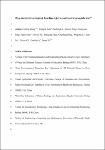May microbial ecological baseline exist in continental groundwater?
| dc.contributor.author | Zhong, S | |
| dc.contributor.author | Zhou, S | |
| dc.contributor.author | Liu, S | |
| dc.contributor.author | Wang, J | |
| dc.contributor.author | Dang, C | |
| dc.contributor.author | Chen, Q | |
| dc.contributor.author | Hu, J | |
| dc.contributor.author | Yang, S | |
| dc.contributor.author | Deng, C | |
| dc.contributor.author | Li, W | |
| dc.contributor.author | Liu, J | |
| dc.contributor.author | Borthwick, AGL | |
| dc.contributor.author | Ni, J | |
| dc.date.accessioned | 2023-08-16T09:55:25Z | |
| dc.date.available | 2023-08-16T09:55:25Z | |
| dc.date.issued | 2023 | |
| dc.identifier.issn | 2049-2618 | |
| dc.identifier.issn | 2049-2618 | |
| dc.identifier.other | 152 | |
| dc.identifier.uri | https://pearl.plymouth.ac.uk/handle/10026.1/21242 | |
| dc.description.abstract |
Background Microbes constitute almost the entire biological community in subsurface groundwater and play an important role in ecological evolution and global biogeochemical cycles. Ecological baseline as a fundamental reference with less human interference has been investigated in surface ecosystems such as soils, rivers, and ocean, but the existence of groundwater microbial ecological baseline (GMEB) is still an open question so far. Results Based on high-throughput sequencing information derived from national monitoring of 733 newly constructed wells, we find that bacterial communities in pristine groundwater exhibit a significant lateral diversity gradient and gradually approach the topsoil microbial latitudinal diversity gradient with decreasing burial depth of phreatic water. Among 74 phyla dominated by Proteobacteria in groundwater, Patescibacteria act as keystone taxa that harmonize microbes in shallower aquifers and accelerate decline in bacterial diversity with increasing well-depth. Decreasing habitat niche breadth with increasing well-depth suggests a general change in the relationship among key microbes from closer cooperation in shallow to stronger competition in deep groundwater. Unlike surface-water microbes, microbial communities in pristine groundwater are predominantly shaped by deterministic processes, potentially associated with nutrient sequestration under dark and anoxic environments in aquifers. Conclusions By unveiling the biogeographic patterns and mechanisms controlling the community assembly of microbes in pristine groundwater throughout China, we firstly confirm the existence of GMEB in shallower aquifers and propose Groundwater Microbial Community Index (GMCI) to evaluate anthropogenic impact, which highlights the importance of GMEB in groundwater water security and health diagnosis. | |
| dc.format.extent | 152- | |
| dc.format.medium | Electronic | |
| dc.language | en | |
| dc.publisher | Springer Science and Business Media LLC | |
| dc.subject | GMEB | |
| dc.subject | Bacterial community | |
| dc.subject | Keystone taxa | |
| dc.subject | Deterministic processes | |
| dc.subject | Groundwater | |
| dc.title | May microbial ecological baseline exist in continental groundwater? | |
| dc.type | journal-article | |
| dc.type | Article | |
| plymouth.author-url | https://www.ncbi.nlm.nih.gov/pubmed/37468948 | |
| plymouth.issue | 1 | |
| plymouth.volume | 11 | |
| plymouth.publication-status | Published online | |
| plymouth.journal | Microbiome | |
| dc.identifier.doi | 10.1186/s40168-023-01572-4 | |
| plymouth.organisational-group | |Plymouth | |
| plymouth.organisational-group | |Plymouth|Faculty of Science and Engineering | |
| plymouth.organisational-group | |Plymouth|Faculty of Science and Engineering|School of Engineering, Computing and Mathematics | |
| plymouth.organisational-group | |Plymouth|Users by role | |
| plymouth.organisational-group | |Plymouth|Users by role|Academics | |
| dc.publisher.place | England | |
| dcterms.dateAccepted | 2023-05-13 | |
| dc.date.updated | 2023-08-16T09:55:25Z | |
| dc.rights.embargodate | 2023-9-6 | |
| dc.identifier.eissn | 2049-2618 | |
| dc.rights.embargoperiod | forever | |
| rioxxterms.versionofrecord | 10.1186/s40168-023-01572-4 |


